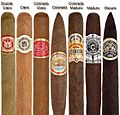Cigar facts for kids
A cigar is a special roll of tobacco that people use. It's usually bigger than a cigarette. Cigars are made from different kinds of tobacco leaves. These leaves are prepared in many ways to create unique smells and tastes.
Most good cigars are rolled using a tobacco leaf. However, some newer cigars use different types of paper instead of a tobacco leaf. This can make the cigar look smoother. Large companies often use machines to roll and pack cigars. But many people believe that cigars rolled by hand are still the best, even if they cost more.
Cuba is very famous around the world for its cigars. Many other countries also make cigars, especially in Central America and the Caribbean islands.
Contents
How Cigars Are Made
Tobacco Leaves and Curing
Cigars start with special tobacco plants. After the leaves are picked, they go through a process called "curing." Curing means drying the leaves slowly. This process changes their color, smell, and taste. It's a bit like how fruits are dried to make them last longer and taste different.
Rolling the Cigar
A cigar has three main parts: the filler, the binder, and the wrapper.
- The filler is the tobacco inside. It can be long pieces of tobacco or shorter, chopped pieces.
- The binder is a special leaf that holds the filler together.
- The wrapper is the outermost leaf. It's usually a very smooth and perfect leaf that gives the cigar its final look.
Skilled workers often roll cigars by hand. They carefully arrange the filler tobacco, wrap it with the binder, and then finish it with the wrapper leaf. This takes a lot of practice to do well.
Where Cigars Come From
Cigars have a long history. They were first used by native people in the Americas. When Christopher Columbus arrived, he saw people using tobacco in this way. He then brought tobacco back to Europe.
Today, many countries grow tobacco and make cigars.
- Cuba is known for its high-quality cigars.
- Other important cigar-making regions include the Dominican Republic, Honduras, and Nicaragua. These places have the right climate and soil for growing good tobacco.
Cigar Sizes and Shapes
Cigars come in many different sizes and shapes. These are called "vitolas."
- Some cigars are long and thin.
- Others are short and thick.
- The size and shape can affect how the cigar feels and smells.
The color of the wrapper leaf can also vary a lot. Darker wrappers often mean the tobacco has been aged longer or fermented more. This means it has been processed for a longer time.
Images for kids
-
Indigenous tobacco pipe on display at the regional museum in San Andrés Tuxtla
-
Inside an Ybor City cigar factory c. 1920
-
Hand rolling cigars and relevant artifacts, Ybor City Museum State Park display, Tampa, Florida
-
Cigar makers in Puerto Rico, c. 1942
-
Vendor rolling cigars at the Eyipantla Falls in San Andrés Tuxtla, Mexico
-
World's largest cigar at the Tobacco and Matchstick Museum in Skansen, Stockholm, Sweden
-
Illustration with photographs of tobacco leaves infested by Lasioderma serricorne (tobacco beetles), from Runner, G. A., The tobacco beetle (1919), Bulletin of the U.S. Department of Agriculture, Biodiversity Heritage Library
-
A cigar case made of crocodile skin with sterling silver appointments bearing a Birmingham hallmark for 1904
-
Display of various cigar cases with prices in a cigar store in Amsterdam, Netherlands
See also
 In Spanish: Puro para niños
In Spanish: Puro para niños




















